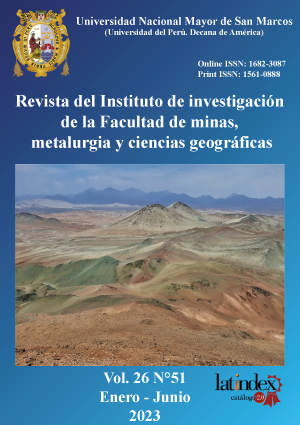Impacto del cambio climático en factores hídricos de la cuenca inferior de los ríos Chira y Piura
DOI:
https://doi.org/10.15381/iigeo.v26i51.25292Palabras clave:
Cambio climático, cuenca Chira-Piura, factores hídricos, hidrología, impacto climáticoResumen
La cuenca hidrográfica Chira-Piura es un proveedor esencial de agua en el norte peruano. A pesar de su naturaleza y capacidad hídrica la población se encuentra amenazada por desabastecimientos debido a los embates de la naturaleza. Este 2023 el ciclón Yaku, ocasionó fuertes gradientes térmicos, alteró los factores hídricos, trajo consigo inundaciones y afectó la atención de la demanda de agua, que en estas regiones semiáridas se ve alterada por el cambio climático. Los objetivos trazados con este trabajo de investigación son el desarrollo de herramientas conceptuales para el estudio de la alteración de las variables hídricas de la cuenca Chira-Piura y sus efectos adversos frente a fenómenos climatológicos más frecuentes e intensos. Se hace uso del diseño no experimental transversal, correlacional, de alcance descriptivo, en un enfoque cuantitativo, con un análisis estadístico comparativo de parámetros hidrológicos y climáticos. Debido al cambio climático, se proyecta que los próximos eventos pueden ser más intensos y el Fenómeno de El Niño más frecuente, incidiendo en los patrones usuales de lluvias y caudales. Se han identificado desafíos asociados con la prevención de inundaciones y oportunidades futuras que incluyen el desarrollo de conjuntos de datos de calidad e inclusión de técnicas de asimilación de datos y modelos hidrológicos.
Descargas
Publicado
Número
Sección
Licencia
Derechos de autor 2023 Gina Chambi Echegaray, Carlos Francisco Cabrera Carranza, Jesús Torres Guerra, Mario Dominico Rodríguez Delgado, Nora Malca-Casavilca, Eric Rendon Schneir, Beatriz Gina Herencia Félix

Esta obra está bajo una licencia internacional Creative Commons Atribución 4.0.
LOS AUTORES RETIENEN SUS DERECHOS:
a. Los autores retienen sus derechos de marca y patente, y tambien sobre cualquier proceso o procedimiento descrito en el artículo.
b. Los autores retienen el derecho de compartir, copiar, distribuir, ejecutar y comunicar públicamente el articulo publicado en la Rev. Inst. investig. Fac. minas metal cienc. geogr. (por ejemplo, colocarlo en un repositorio institucional o publicarlo en un libro), con un reconocimiento de su publicación inicial en la Rev. Inst. investig. Fac. minas metal cienc. geogr.
c. Los autores retienen el derecho a hacer una posterior publicación de su trabajo, de utilizar el artículo o cualquier parte de aquel (por ejemplo: una compilación de sus trabajos, notas para conferencias, tesis, o para un libro), siempre que indiquen la fuente de publicación (autores del trabajo, revista, volumen, numero y fecha).






